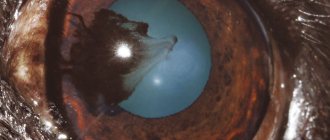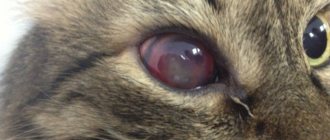16379Pavel
1
In order for a cat to always be healthy and cheerful, the breeder must carefully monitor the health of his pet. You should not think that the animal does not need full care and can be spared various problems and diseases. Particular attention should be paid to the visual organs, because they are the ones who can primarily tell you about the animal’s health status. Many people often notice a spot on a cat’s eye, but they just don’t know what to do about this symptom. But this may indicate serious pathological processes in the pet’s visual organ.
Causes of spots on the eye
A cloudy spot in a cat's eyes may occur due to damage to the cornea of the visual organ. Often a small spot or film with a milky tint appears on the surface of the eye. If a cataract appears on the surface of the visual organ, this usually indicates that the cat or dog is experiencing a decrease in visual acuity.
© shutterstock
The main reasons for the appearance of spots on the eye are the following pathological conditions::
- corneal lesions . This may be associated with certain pathological processes of an inflammatory and infectious nature, as well as injuries;
- the presence of turbidity in the intraocular fluid . This condition may result from the accumulation of large numbers of white blood cells, proteins or lipids;
- clouding of the lens during the development of cataracts;
- vitreous diseases.
Many people believe that an iris spot is a simple scar on the surface of the eye, but this is not so. The etiology of this symptom is quite wide, and sometimes it can be very serious.
Appearance
Areas of dark brown pigmentation within the iris. There may be one or more areas of pigmentation. The spots usually occur in only one eye, but in some cases both eyes can be affected. The spots may start small and gradually increase in size and become darker. If there are several spots, they may merge as they grow.
Iris melanosis is flat and should not protrude above the surface of the iris. Malignant melanomas are lumpy, raised, and can cause deformation of the ocular surface.
© shutterstock
While iris melanosis is painless, infiltration of the adjacent drainage angle can cause glaucoma, an extremely painful increase in intraocular pressure.
Types of stains
Cats may not always develop an eyesore; the formations may have different colors. They may not appear immediately, but over the course of some years (usually 2-3 years). At first, the owner may not see a spot on the surface of the cat’s or dog’s visual organ, but gradually it will become visible and become larger and larger.
Spots are classified into several types:
- light . These types of spots can appear if there are pathologies of the spine, neuralgia, radiculitis, neuroses, psychoses, kidney damage, liver damage;
- brown with a red tint . These formations on the iris occur after infectious pathologies;
- dark spots . They appear in cancer;
- with a red tint . If a cat has a red spot above the eye, this may be due to enzymatic changes in the liver;
- education with the type of “present” tobacco . These symptoms occur with constipation, chronic colitis, and lesions in the pancreas.
© shutterstock
Symptoms
If brown spots and formations appear on the cat's eyes, symptoms may appear, which are definitely recommended to be closely monitored. Visual acuity may decrease, the animal may not get into the bowl, it may skid when turning, and orientation in space may also be disturbed. The second aspect is considered to be increased irritability and nervousness of the pet. The cat begins to behave aggressively towards its owners and other pets in the house. Often a person notices the development of strabismus in a cat, the appearance of watery discharge from the eyeball. There is severe swelling of the cornea and redness on the iris and eyelids.
If such symptoms appear, it is recommended to immediately take your pet to an appointment with a veterinarian. When examining a cat, a specialist will prescribe appropriate treatment and tell you about methods for preventing the development of such diseases. Self-medication is prohibited.
Operations for corneal opacities
Various techniques and protocols are successfully practiced, selected “according to indications” depending on the specific clinical situation. Typically, penetrating or partial keratoplasty is used - respectively, complete (over the entire thickness and area) or partial, more gentle replacement of the affected area or layer of the cornea with a donor keratobioimplant. Such operations are well established and, as a rule, effective, especially if all instructions for the rehabilitation period are followed, which in some cases can last up to a year or more.
According to statistics, the most successful, in terms of short-term and long-term prognosis, are operations for keratoplasty of cataracts caused by infectious ulcerations/scarring. A necessary condition is sanitation and prevention of recurrence of infection.
As for the prevention of the cataract itself, the first and main rule should be to contact a qualified ophthalmologist for any signs of conjunctivitis or other inflammatory process (before the cornea is involved in it), for any injuries and burns of the eye. In a very significant proportion of cases, the cataract could have been prevented without delaying the situation and without bringing the situation to ophthalmic surgery.
Prevention measures
If floating black dots have just begun to appear in your field of vision. They still have a small number and do not reduce the quality of life, but they are already tiring with their presence, it is worth reconsidering the usual way of life. Perhaps by changing it, the problem will stop getting worse and there will simply be no reason to see a doctor. Here's what you need to change in your daily life:
- Become more active;
- Regularly engage in sports or physical activity;
- Be in the fresh air more often;
- Quit smoking;
- Do not abuse alcohol;
- Review your diet and ensure your body receives the required amount of vitamins and minerals;
- Get enough sleep;
- Limit visual stress.
Jaundice in cats, necessary therapy
- Therefore, often, while awaiting the results of laboratory tests, the veterinarian will prescribe supportive measures for the cat:
- droppers to combat dehydration, correct the level of electrolytes in the blood if the animal suffers from anorexia, vomiting and diarrhea;
- drugs that lower blood sugar levels (as indicated);
- the use of drugs for anemia, hematopoietic stimulants, donor blood transfusions for severe anemia;
- course of antibiotics, antiemetic drugs.
Once the test results are in and the underlying cause of the jaundice is found, your veterinarian will decide on more targeted treatment. This can be surgical intervention (for example, if stones are found in the gall bladder or it is necessary to remove a tumor), and antiparasitic therapy, and the introduction of antidotes for poisoning with certain toxic substances. As you can see, there are many causes of jaundice in cats, so treatment protocols will vary greatly, as will the prognosis for recovery.
Therapy for jaundice will be aimed not only at eliminating its root cause (for example, infection or tumor), but also at stopping the processes that it caused. This may be pain syndrome (with obstructive jaundice), oxygen deficiency, or intoxication of the body. For these purposes, analgesics, oxygen therapy, droppers with hepatoprotective drugs, etc. will be used.
Another area of treatment is to combat symptoms such as diarrhea, vomiting, anemia, and dehydration.
. This will also require the introduction of intravenous drips, vitamin complexes, electrolytes, drugs against vomiting and increased stomach acidity.
Cat care
Mandatory recommendations when caring for a cat with liver failure are:
- strict adherence to veterinary prescriptions,
- a special gentle diet (consult your doctor to create a treatment menu for your cat),
- control by the veterinarian over the healing process,
- rest, peace, lack of stress for a sick animal.
Owners' fears
Sometimes cat owners, having discovered that they have jaundice, begin to worry about the health of all household members, worrying that the infection does not turn out to be contagious. In most cases, these fears are unfounded; feline hepatitis is not transmitted to humans. Of course, you must monitor the health of your pet, there are diseases that are common to us and our smaller brothers, but in the case of jaundice, you only need to worry about the health of your pet!
If you see symptoms of jaundice in a cat, call our center and you will receive a free consultation to provide first aid to your animal. At your request, the doctor will come to you at any time within 40 minutes if you need emergency help. Many medical procedures and express tests for the presence of certain infections can be done at home without wasting precious time. Remember that in this case, time should work for you, and not for the disease, since the animal often dies without timely help.
Treatment of jaundice requires an integrated approach
, therefore, on the basis of ours, you can examine your pet comprehensively, not excluding ultrasound and x-rays. Severe patients will be admitted to hospital for urgent treatment with modern drugs. After recovery, the treating veterinarian will provide advice so that the cat with jaundice can lead a healthy and active life!
Blurred vision in one or both eyes
Blurry vision is when your vision loses its sharpness and instead of seeing a clear picture, you see a cloudy image. Objects seem to be out of focus and have blurry outlines.
It is quite logical that such a problem causes concern. There are many reasons for blurry vision. This can be myopia, farsightedness, astigmatism, presbyopia, all these vision problems are related to refractive error. Sometimes loss of picture clarity can be evidence of dangerous diseases and neurological disorders that cannot be ignored.
If you have problems with your vision, the first thing we do is go to the doctor, he will check your eyes in all respects and determine whether treatment is needed. It is very important to have your eyes examined comprehensively.
Causes of loss of vision clarity and how to cure it
Myopia or myopia: In this case, you feel excessive tension in your eyes, even causing headaches. Strabismus and blurred vision may appear in one eye or both.
Treatment options include wearing glasses, contact lenses, surgical methods such as LASIK or photorefractive keratectomy.
Farsightedness: in this case, you can see objects in the distance perfectly, but not up close. To look at an object up close, you have to strain your eyes. In this case, the eyes become very tired. Treatment options are similar to myopia - glasses, contact lenses or refractive eye surgery.
Astigmatism: If you have trouble seeing objects both near and far, this may be a sign of astigmatism. Its cause is the deformed shape of the cornea.
In this case, the light rays are not focused on the retina, which means that a clear picture does not form; the distance to the object in this case does not matter.
Treatment methods: glasses, contact lenses, surgery.
Presbyopia: This disease is a consequence of the natural aging of the body. And if your age has exceeded the mark of forty years, do not be surprised that you find it difficult to read text messages on your phone or the small print on the packaging. As a treatment, your doctor may prescribe glasses to correct refractive errors and presbyopia. Additional options in glasses such as anti-reflective coating and photochromic lenses are very important. For more information about the best glasses to choose, talk to your eye doctor.
Chronic Dry Eye Syndrome: If your eyes often become dry, this may cause your vision to become blurred from time to time. As a treatment for this disease, your doctor will recommend you artificial tears - these are drops that have a lubricating effect. If the situation is very serious, then the doctor will prescribe prescription medications or special plugs inserted into the lacrimal canal - they have several names - obturators, punctal occluders.
Pregnancy: When a woman is expecting a baby, her body often produces surprising reactions, including vision problems - blurred vision or double vision. Hormones are to blame for everything - they can influence the shape and thickness of the cornea. All this leads to blurry vision. Often, blurred vision is a consequence of dry eyes, which also often happens during pregnancy.
Ocular migraines or migraine headaches:
Migraine is an extremely unpleasant condition, but not dangerous in general. Symptoms include the appearance of a veil before the eyes, flickering light and luminous zigzags.
Floaters: You may experience vision problems when some strange floaters float in front of your eyes. Very often, this problem appears with age: the gel-like vitreous body of the eye loses its dense structure over the years and becomes more liquid. Tiny pieces of tissue inside it float freely around the eye and cast shadows on the retina, which is why we see floating objects.
Blurred vision after LASIK surgery: After refractive surgery, your vision may be blurry. But this unpleasant effect goes away after a few days. However, it will take a little longer for your vision to return to normal.
Eye drops and medications: the cause of blurred vision, as well as eye irritation, can be eye drops, or rather the preservatives that are included in their composition. Dry eyes and blurred vision may result from the use of histamines. These side effects are usually indicated in the instructions for the medications. If you don't know why your vision is blurry, you can ask your doctor, and he will find out if it is a “side effect” from any medications.
Uncontrolled wearing of contact lenses: Usually you can wear lenses for a short period of time, this period is indicated on the lenses themselves, but very often we neglect these recommendations. If you wear contact lenses for too long, dirt, including protein, accumulates in them. Not only can this cause blurred vision, but it can also cause an eye infection.
Blurred vision as a symptom of dangerous vision problems
Eye diseases: If you are over 60 years old and feel that your vision is suddenly blurred, you are at risk of developing a macular hole - a retinal tear. The consequence of many eye diseases can be irreversible loss of vision, so you should immediately go to the hospital if you feel that your vision has sharply deteriorated.
Cataract: This disease is dangerous because if left untreated, you can go completely blind. Symptoms of cataracts are blurred vision, glare and halos around the light at night, the solution is cataract surgery and an artificial lens. These surgeries will restore lost vision.
Glaucoma: symptoms are blurred vision and tunnel vision. It is very important to start treatment on time, otherwise you may completely lose the ability to see.
Age-related macular degeneration: With this disease, you suffer not so much from blurry images, but from the fact that the image becomes distorted - straight lines become waves or become choppy. This age-related disease is again dangerous because you can become completely blind.
Diabetic Retinopathy: Diabetes can lead to diabetic retinopathy, which is a dangerous disease that causes severe damage to the retina of the eye.
Cardiovascular diseases and other systemic diseases: blurred vision can be a signal of the onset of an extremely dangerous disease such as a stroke or cerebral hemorrhage. This could also be the first sign of multiple sclerosis. Therefore, if you suddenly feel that your vision has lost clarity or you are seeing double, you should immediately seek medical help.
Source: https://www.allaboutvision.com/conditions/blurry-vision.htm
Blurry vision in one or both eyes
Aimee Rodriguez; tested by optometrist Gary Heiting
Papilloma
The causative agent of benign formations called “papillomas” is human papillomavirus. Most often, infection with this virus occurs during birth from mother to child, but the disease can also be acquired during life through contact with infected people. The virus can appear on almost any area of the skin and mucous membranes in the form of round growths. Papilloma is usually painless. However, it can hardly be called “aesthetically attractive”, so it causes significant discomfort.
You can distinguish papilloma from other types of formations by the following characteristics:
- the cone is more like a ball on a stalk or has a mushroom-like shape;
- the wart-like growth has a rough surface that resembles the surface of cauliflower to the touch.
It is worth noting that a growth with a smooth surface is not a papilloma, and it must be examined by an oncologist.
Treatment of papillomas should be comprehensive. Surgical removal is performed by a dermatologist. He also examines the type of virus and prescribes drug treatment. The fact is that the manifestation of a disease at one point does not mean that the entire body is not infected. The virus is suppressed by the immune system, but travels through the bloodstream. Some types of human papillomavirus are very dangerous with a high probability of degeneration of skin formations. Only an experienced dermatologist can prescribe adequate treatment based on diagnostic results. Measures to improve overall immune status are essential in the treatment of papillomas.
Chalazion
Cones of this type are quite common. They develop from a sebaceous gland whose duct is blocked. This formation is also called a “grading lump” or “cold barley.” The continued production of sebaceous gland secretion leads to the accumulation of a viscous mass in the capsule, which stretches and thickens, taking the form of a dense lump. On palpation, the contents under the skin feel like a moving ball.
Cold barley develops at a slow pace, so it does not cause pain. Only a formed hard capsule can cause pain when squeezed. If a chalazion is not treated, it can develop into a cyst. As the lump develops, the risk of complications increases: inflammation, formation of a purulent fistula, granulation.
Millums (millet)
This type of bump occurs with equal frequency on the upper and lower eyelids. Millet grains can range in size from a poppy seed to a grain of rice and usually form in groups. Millums are the most harmless of all formations and cause only aesthetic discomfort. At its core, these are whiteheads localized in the eyelid area.
Millet removal should only be done by a cosmetologist. Since they do not carry the risk of complications, they are not considered an ophthalmological disease, but fall within the competence of a dermatologist-cosmetologist.
Prevention of millums includes caring for the eyelids, timely removal of dead epidermal cells, ensuring the cleanliness of the ducts of the sebaceous glands and pores of the skin around the eyes, as well as a balanced diet that excludes excessive consumption of fatty foods.
Barley
Styes are more common than chalazions. This type of lump on the lower or upper eyelid is caused by inflammation of the follicle (bulb) of the eyelash. This also clogs the sebaceous gland duct. Styes develop over several days or even hours and can occur in both adults and children. More often, the systematic appearance of barley is observed in people with weakened immune systems or who have changed their place of residence to an area with a more severe climate, as well as in people exposed to constant stress factors.
Based on their origin, there are two types of barley. Inflammation can be external (when the sebaceous gland suppurates) and internal (when the source of inflammation is located in the membolic gland).
The development of external styes is characterized by subjective sensations similar to a foreign body entering the eye. The initial stage may also be accompanied by stabbing pain. External stye visually manifests itself as redness and swelling of the eyelid. The internal one is usually not so noticeable, but it causes even more discomfort and pain.
Without treatment, barley develops within a few days into an abscess, which opens with the release of purulent contents. This brings relief, but an open wound is dangerous due to the possibility of re-infection.
It is better to start treating barley without waiting for the abscess to spontaneously break through. This allows you to get rid of the painful lump faster and with less risk of complications. If you still don’t have the courage or time to visit an ophthalmologist, you should remember that prolonged suppuration of the eyelid is very dangerous. If the stye does not open for more than two weeks, surgical treatment is necessary. An ophthalmic surgeon will remove the abscess under local anesthesia and give recommendations for further treatment of the eyelid. Most often, therapy for developing or already opened barley includes drops and ointments that contain antibiotics (albucid, gentamicin, erythromycin, tetracycline ointment).
Diagnostic and treatment methods
When visiting a specialist, blood must be taken from the animal for testing.
When examining a furry patient, a veterinarian, namely an ophthalmologist, will make an accurate diagnosis and prescribe appropriate treatment. To confirm the diagnosis, the following procedures are prescribed:
- taking tests and examining them, especially blood and serology;
- measurement of intraocular pressure and comparison with healthy indicators;
- performing a cytology procedure;
- taking a smear from the eyeball and examining them;
- culture examination of the microflora of the eye and intraocular fluid.
A darkened iris in a kitten can only be cured with medication, after examining the test results by a professional doctor. Once the diagnosis becomes known, such diseases can be treated by carrying out procedures such as washing the eyeball with Metrogyl, or you can administer the drug Gamavit parenterally. It is also possible to lubricate the inflamed area with tetracycline ointment.
If, after testing, glaucoma is detected, then surgery may be necessary. Only the treating doctor should treat spots on an animal’s cornea, otherwise it can cause harm to the pet. It is not recommended to self-medicate, since the appearance of spots is considered a symptom of serious pathological changes in the cat’s body. Timely medical care will help protect your pet from discomfort, illness and dangerous consequences.
3.What should you pay attention to?
Eye moles do not affect vision in any way. However, a spot in the eye requires special attention and consultation with an ophthalmologist. Normally, the edges of the nevus are clearly defined, the surface is velvety in appearance, and the shape and color do not change significantly. If growth and changes in the spot become noticeable, it is necessary to undergo a series of examinations, and, if necessary, treatment or even removal of the pigment spot. Also alarming symptoms should be:
- blurred vision;
- limited field of view;
- sensation of a foreign object in the eye.
Even if the nevus in the eye is stable and does not cause a person any concern, one must remember that, like any mole, it is extremely undesirable to expose it to ultraviolet radiation and other influences that provoke mutations. In sunny weather, it is very advisable to protect your eyes with dark glasses or at least wear a hat with a visor.
About our clinic Chistye Prudy metro station Medintercom page!











